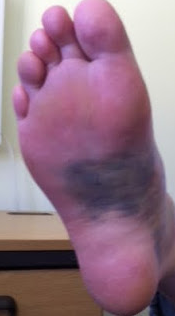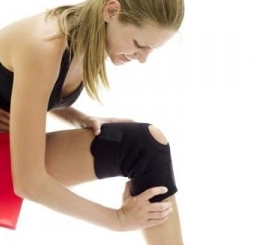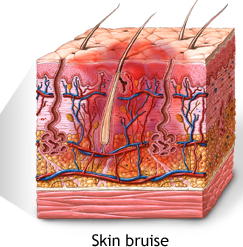A bruised toenail is normally not a serious health concern but can limit your productivity tremendously or even lead to more serious problems if not handled properly. This article will highlight some of the most common causes, symptoms and treatments for this toenail problem.
Bruised Toenail Causes
A bruised toenail occurs as a result of damage to the underlying soft tissues or bone without a breakage of the skin. It is often characterized by rupturing of blood vessels, leaking blood into the surrounding soft tissues. This gives rise to the blue-black discoloration that is typical of most cases of toenail bruising.
The following are some of the most commoncauses of toenail bruising:
- Trauma from a blunt object e.g. when someone stubs his toe, they may end up with a bruised toenail
- Repetitive use of a toenail e.g. from running or dancing
- Use of anti-coagulation medications such as warfarin
- Car accidents
- Sports accidents e.g. when someone accidentally steps on your toes in a football game
Bruised Toenail from Running
A bruised toenail from running, otherwise known as “Jogger’s toenail” is a common effect of injury to the soft tissues underlying the toenail. It is commonly associated with a buildupof blood (subungal hematoma) beneath the toenail as a result of damage to blood vessels leading to leakage of blood.
Runners spend a lot of time on their feet and this coupled with factors such as long nails and wrong choice of running shoes (without enough protective padding) can easily be a precursor for bruising of toenails from running.
Jogger’s feet are typically associated with a blue-black discoloration in one of your toenails, usually as a result of its taking a beating from long running time. Toenailswith bruising are usually painful and unsightly and can result in a bacterial infection if proper care is not accorded. The warm, moist environment in your shoes provides a suitable habitat for bacterial activity.
How jogger’s feet develop: The repeated impacts involved with each step while running are normally to blame for bruised toenail. After each impact with the ground, there is usually a short moment when your foot remain in motion even after the shoe has come to a halt.
The foot consequently slides forward leading to a slightly forceful impact on it which is followed by even more stress as you push your legs off of the ground.
The following are some of the risk factors for bruising of toenails from running:
- Using inappropriate shoes with inadequate padding and inadequate room for your feet and/or toes
- Lots of downhill runs
- Longer running time
Prevention
You can always prevent future incidents of toenail bruising due to running by wearing appropriate shoes with enough padding. You can also get one of the many toe pads and gel pads that are currently available in the market to provide additional cushioning effect. And of course don’t forget to keep your toenails short.
Bruised Toenail Treatment
You can always prevent getting your toenail(s) bruised by wearing well-fitting shoes and socks and keeping the toenails short, but if the worst has already happened, then here are bruised toenail treatment options that you may want to consider:
- Trim the toenail to keep it as short as possible without injuring yourself. Make sure that it is also trimmed flat rather than round to avoid getting an ingrown toenail.
- Soak the toenail (or foot) in warm salty water several times each day (at least 3 days) and follow it up with a topical antibacterial cream such as bacitracin or Neosporin to help prevent infections as the bruise heals.
- Anti-inflammatory medication: taking over-the-counter pain relieving anti-inflammatory drugs such as acetaminophen (Tylenol) may help to relieve pain and swelling.
- Cushioning toe pads: These also forms an important part of treatment as they prevent chafing of toenails against the shoes. These are available in the market under numerous brand names such as Brooks and Aetrex.
- Consider wearing shoes that are bigger than your regular shoe size to allow more room for your toenail as it heals.
You should however see a podiatrist if there is excessive pain or swelling or the bruising takes more than a couple weeks to improve.
How to Heal a Bruised Toenail– Natural Home remedies

As for the lovers of natural home remedies, you will delight in knowing that there are various ways to heal a bruised toenail naturally as highlighted below:
- Fullers earth: Cut the affected toenail short and then cover it with fullers earth which helps in reducing inflammation while keeping the affected area cool.
- Mustard oil: It also helps to massage the affected area with mustard oil. Mustard oil has heat-emitting properties that aid in alleviating inflammation.
- Turmeric paste: You can also apply turmeric paste on the bruised toenail to not only reduce swelling but also prevent infection.
Bruised Big Toenail
“My big toenail is terribly bruised and swollen after my team mate accidentally stepped on my foot during a soccer game. It looks dark blue in color and hurts a lot, especially when wearing shoes.What remedies have anyone used to heal such a situation?” Tom
The prominent position of the big toenail makes it particularly susceptible to bruising. You can however manage it at home with proper treatment regime that integrates pain relief, inflammation reduction, and infection aversion.
A combination of pain relieving medicines such as Tylenol, warm soapy water soaks, and antibiotic creams coupled with lots of rest will do in most cases. If the bruising doesn’t improve for more than a week’s time, however, you should book a consultation with your doctor.
Bruised Toenail Falling Off
“I got a toenail bruising a month ago after stubbing my toe and although the pain and swelling that I experienced during the first few days has since receded, the toenail seems to be falling off now. Should I be scared? Is this a sign of a serious problem that necessitates seeing a podiatrist?” Pauline
As the soft tissues underlying the bruised toenail heal, it is not unheard of for the nail to separate from the nail bed and eventually fall off. After falling off, most toenails grow back in 3 to 5 months, so there is no cause for concern especially given the fact that your initial bruising healed rather well.
Bruise under Toenail
“I enjoy skiing and goes to the mountains every moment I get. I have never had serious issues, but yesterday I stubbed on a rock and sustained a serious ‘beating’ on the toenail. What do you recommend for treatment of a bruise under toenail?” Kim
If the pain is not unbearably severe, you can take care of your condition using a mix of anti-inflammatory medications e.g. acetaminophen (Tylenol) and soaking your toenail in warm soapy water while ensuring that no undue pressure is exerted on the toenail or foot e.g. by wearing open or loose-fitting shoes.
If the toenail is swollen, you may want to apply turmeric paste or mustard oil after cleaning it.
For extremely painful or swollen cases however, you should consider seeing your doctor for proper treatment.
What to Do to Fix a Bruised Toenail
“I hurt my foot last weekend while playing beach soccer and my toenail has everything to show for it. Any idea what to do to fix a bruised toenail?” Cathy
With proper care, the toenail should heal itself in a just a few weeks. Just keep it short and clean (regular soaks in warm salty water) and avert infection by applying an antibiotic cream such as bacitracin, Neosporin etc. ask at your local drugstore. Applying turmeric paste on the toenail also helps to prevent infections.
As for the pain, your best bet to fix a bruised toenail that aches is anti-inflammatory medication such as acetaminophen (commonly sold as Tylenol).
Lastly, you should consider wearing open shoes or cushioning toe pads to relieve pressure from the toenails as they heal.
If the symptoms last longer than a few days before improving or seems to be getting worse even with the above treatment measures, you should consider seeking the attention of a podiatrist.
 eTopical Precious Finds
eTopical Precious Finds



